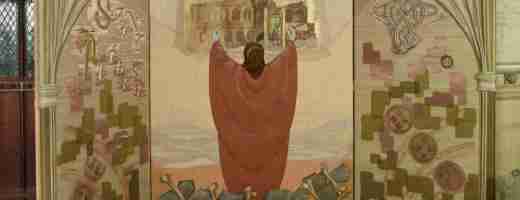Very little is known of the Anglo-Saxon convent and monastery which existed in Bath in the centuries before the Norman Cathedral was built. It seems that there was an Abbey Church in Bath dating from around 757 AD which was part of the Benedictine monastery. This may have existed alongside the earlier convent founded by Abbess Bertana. However there is no archaeological evidence for the Anglo-Saxon Abbey itself. Even the precise site of the building cannot be confirmed, although it probably occupied at least part of the site of today’s Abbey.
King Edgar
In the 10th century England became unified under a line of kings from Wessex, beginning with Edgar whose reign began in 959. King Edgar was crowned King of all England in Bath on Whitsunday 973. The service used for Edgar’s coronation was compiled by Dunstan, who was Archbishop of Canterbury; and formed the basis of all subsequent coronation services, right up to that of the present Queen in 1953. In 1973 Queen Elizabeth II visited Bath Abbey for a service to mark 1000 years since the coronation of King Edgar. There is a stone commemorating this royal visit in the floor of the Abbey by the lectern.
St Alphege
Alphege was a Benedictine monk from Deerhurst in Gloucester who was appointed Abbot of Bath around 980 AD by Archbishop Dunstan. Whilst in Bath he lived a hermit-like life and quickly gained a reputation for his strict adherence to the ascetic lifestyle and for his sternly moral character. He was particularly scathing about those who had taken the habit without fundamentally changing their way of life. This brought him into conflict with the monks in Bath, who appear to have been extremely lax in their observance of the Benedictine Rule. Alphege quickly set about reforming the monastery, and successfully imposed his own rigorous standards of the monastic life.
In 984 Alphege was appointed Bishop of Winchester, and at fifty-two years of age was given the prestigious post of Archbishop of Canterbury in 1005. He led the church in England successfully through the turmoil and chaos of renewed and extensive attacks, but within six years Canterbury was besieged and fell to Danish invaders, They imprisoned Alphege and demanded £3,000 ransom money for his release. It was an enormous amount of money in those days and the Archbishop staunchly refused to pay, even forbidding his friends to do so, as his main concern was that those within his care were not forced to impoverish themselves even further. The Danes were so infuriated that after a drunken feast at Greenwich they clubbed Alphege to death with ox bones.
After his cruel and unjust death Alphege became a national hero. He could easily have secured his own release but chose to sacrifice himself for the welfare of his people and so quickly came to be venerated as a saint in pre-Conquest England. He is said to have been buried in the vault of the original Anglo-Saxon Cathedral at Canterbury next to Archbishop Dunstan. After the Norman Conquest in 1066 Anglo-Saxon saints such as Alphege became less popular; and the Normans began to build cathedrals all over England in their own style.
By the end of the 11th century plans had been made to replace the Anglo-Saxon Abbey with a grand Norman cathedral.
To find out more about St Alphege and his links to Bath, please visit the Church of Our Lady and Saint Alphege in Oldfield Park, Bath.

